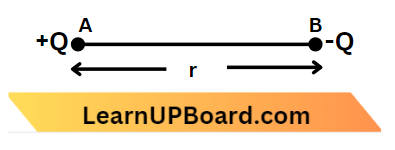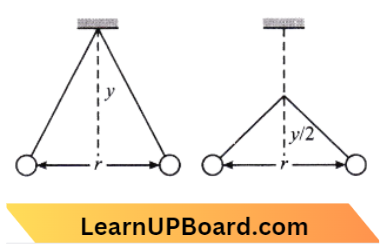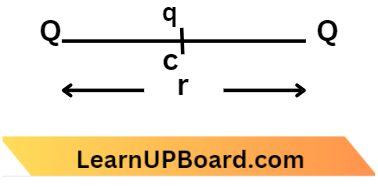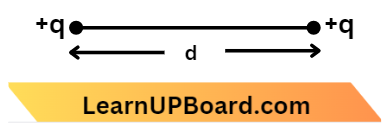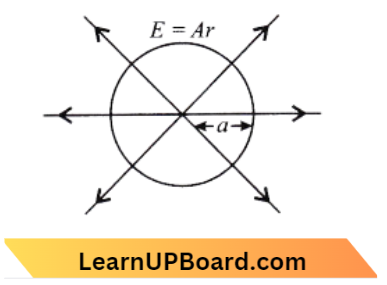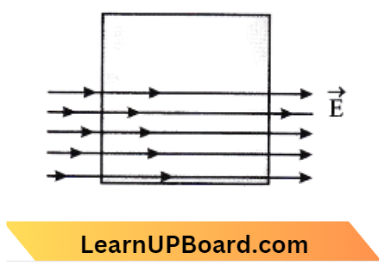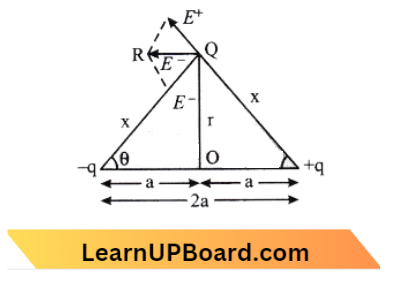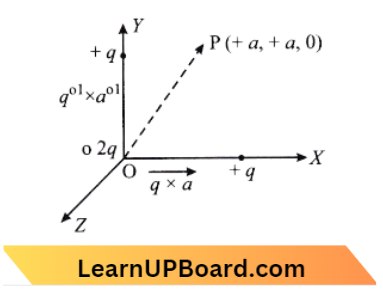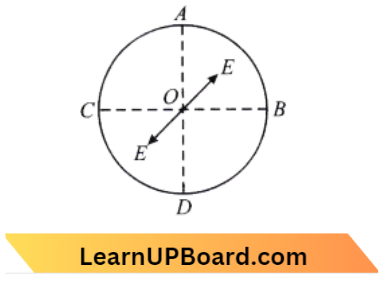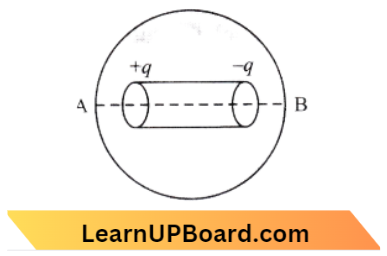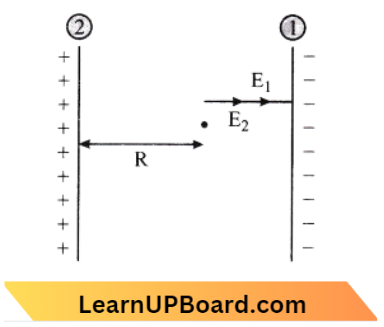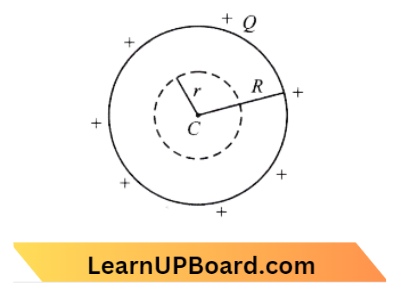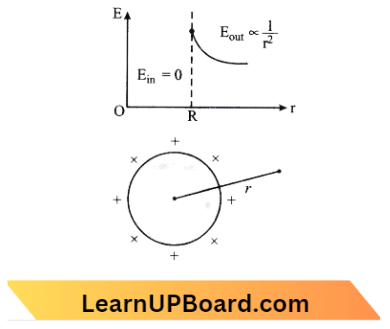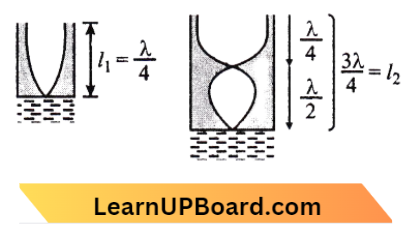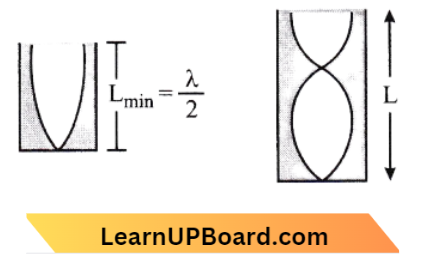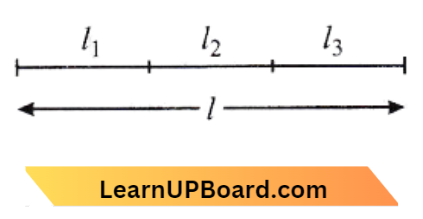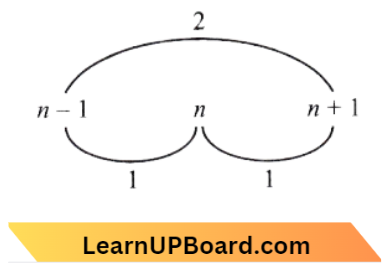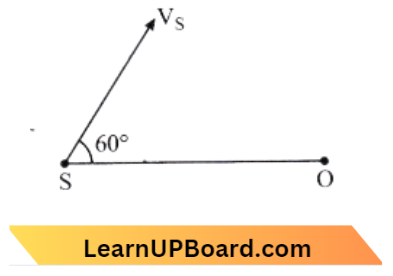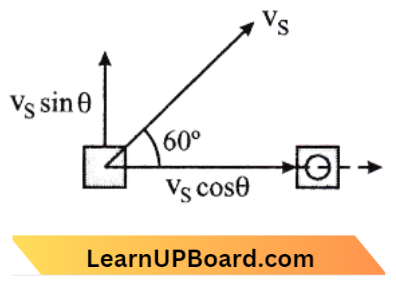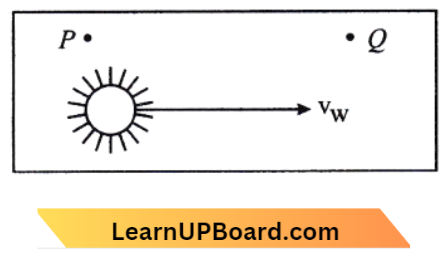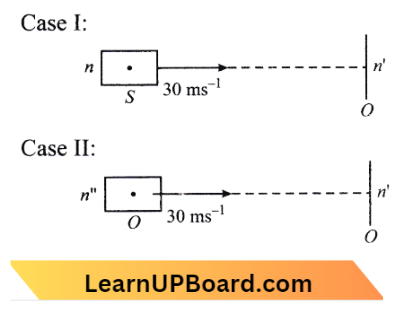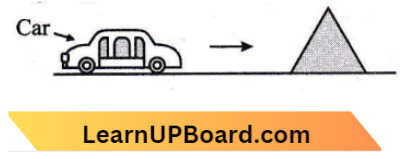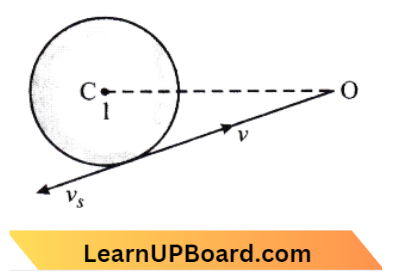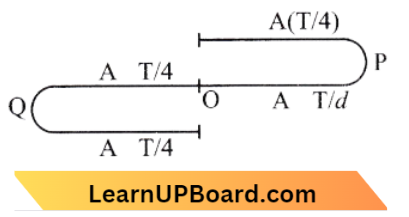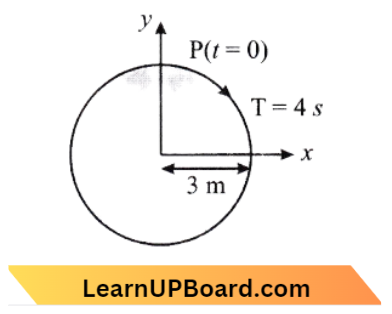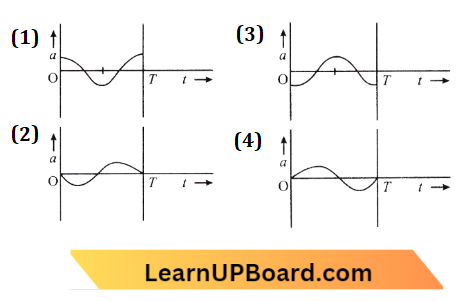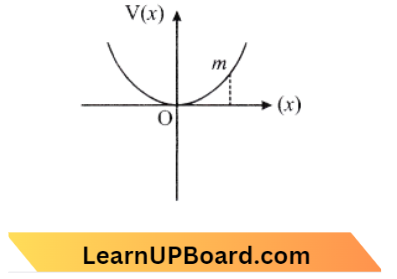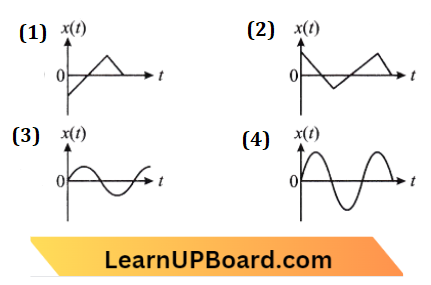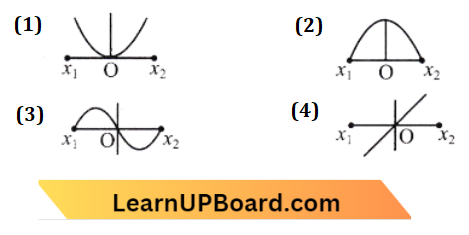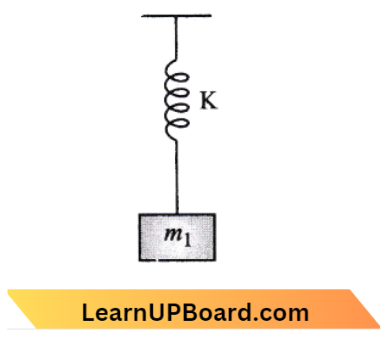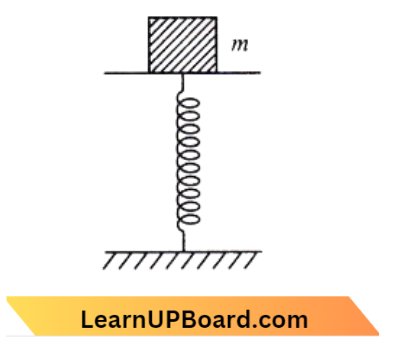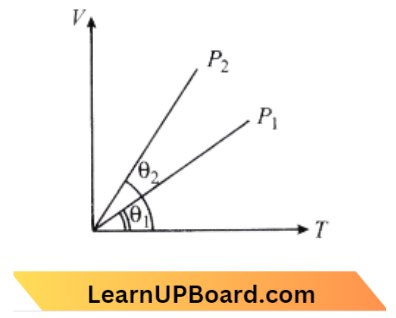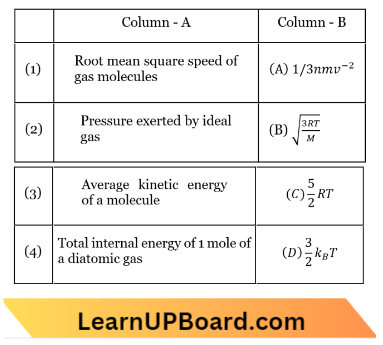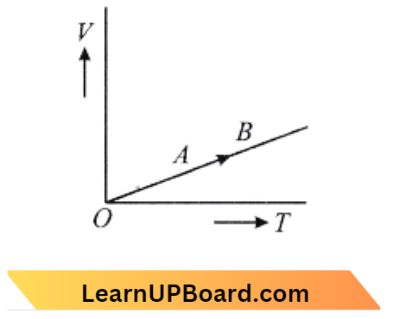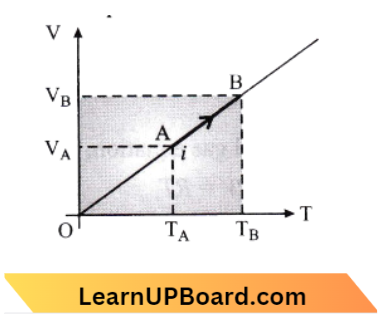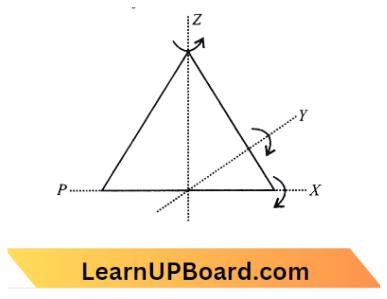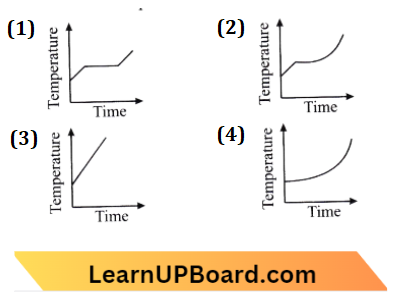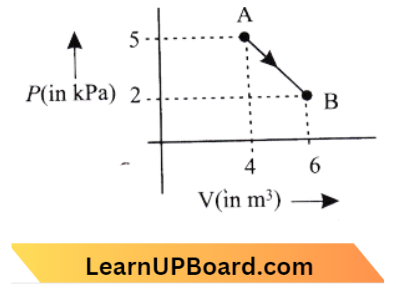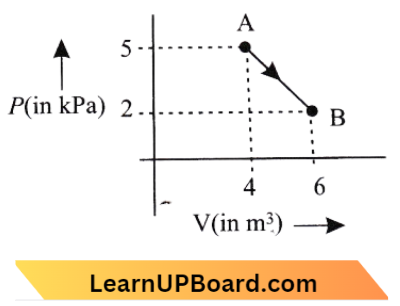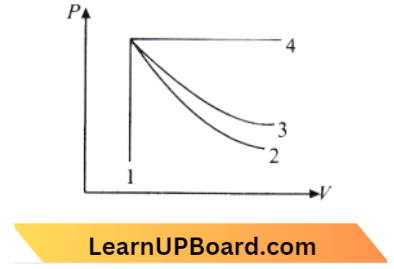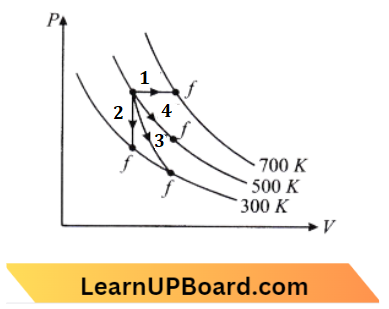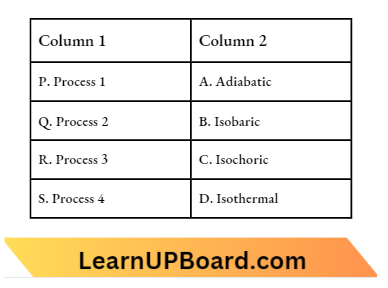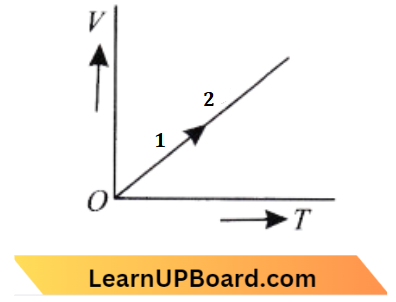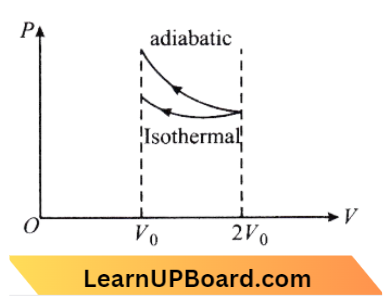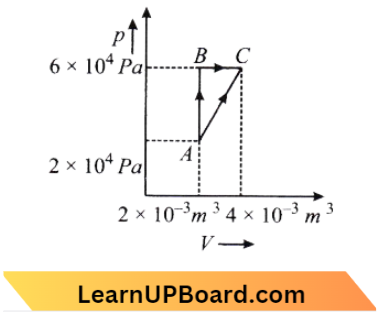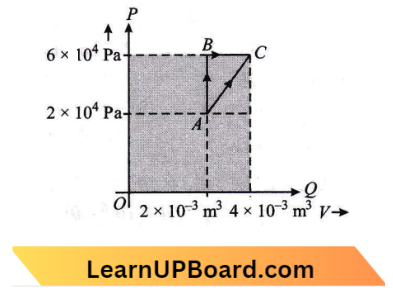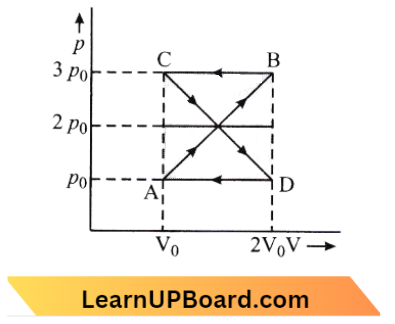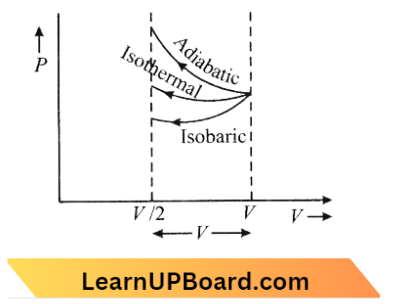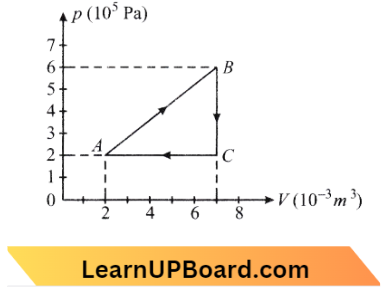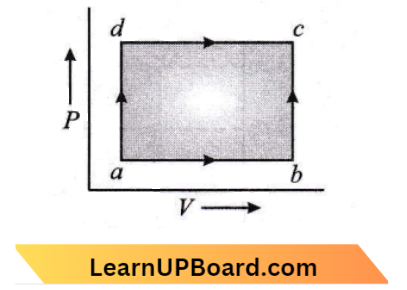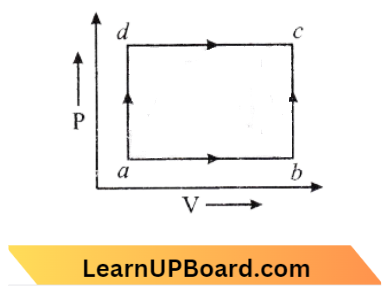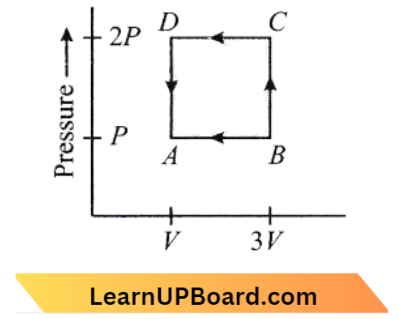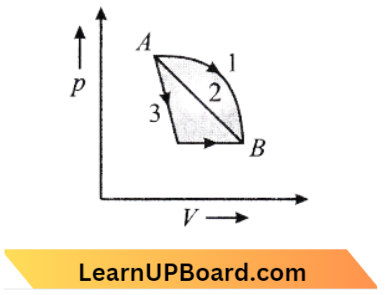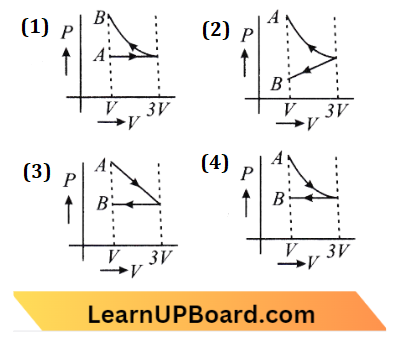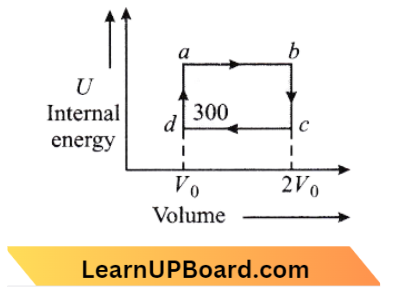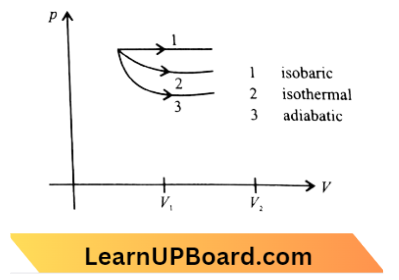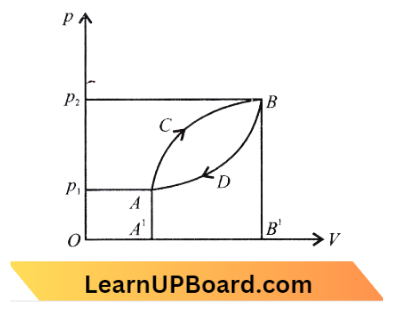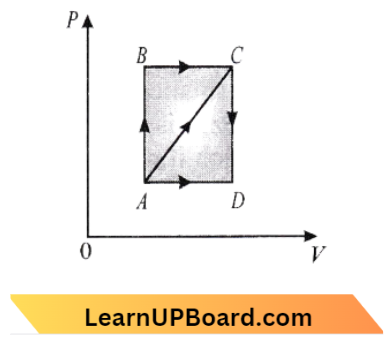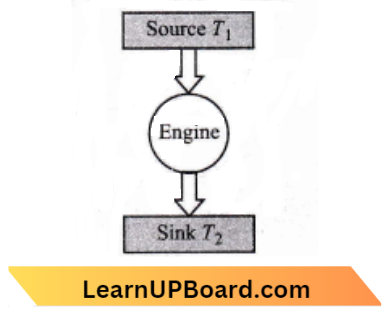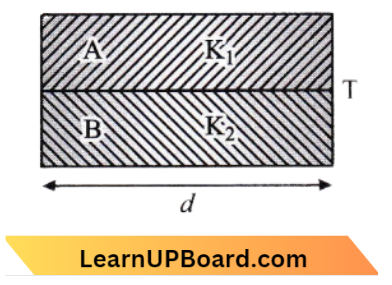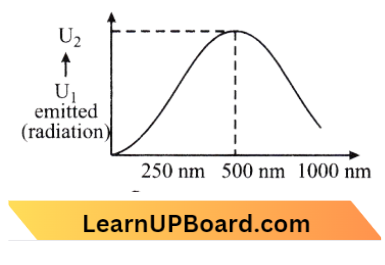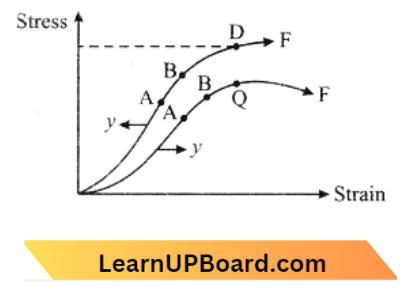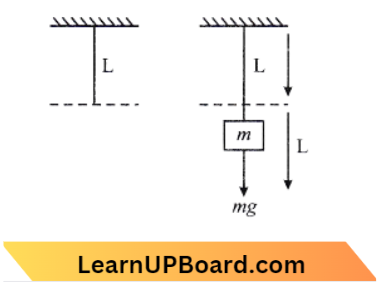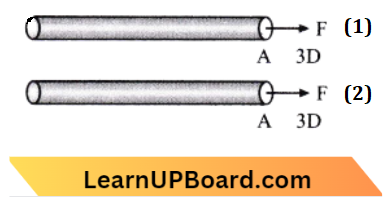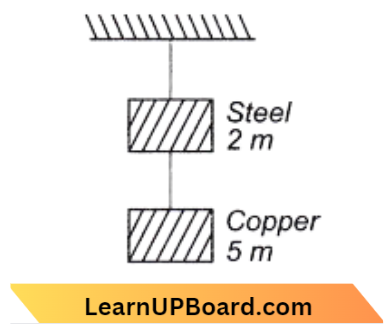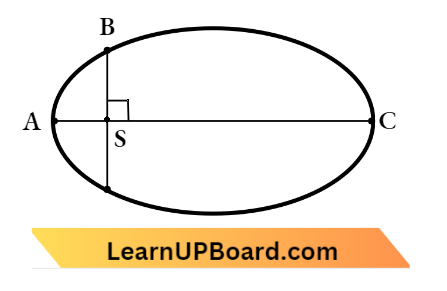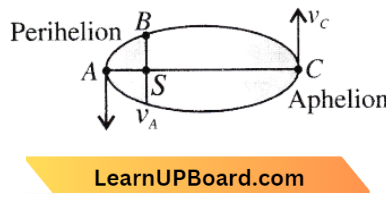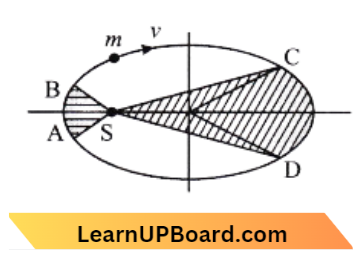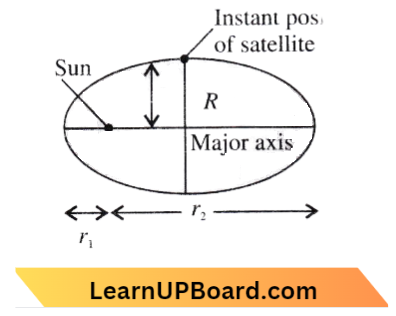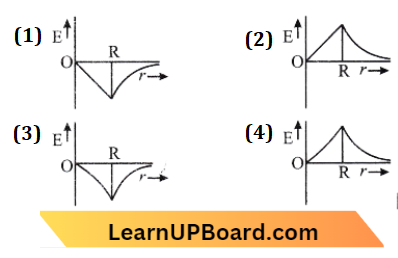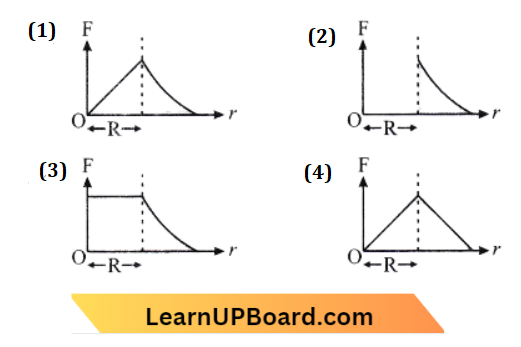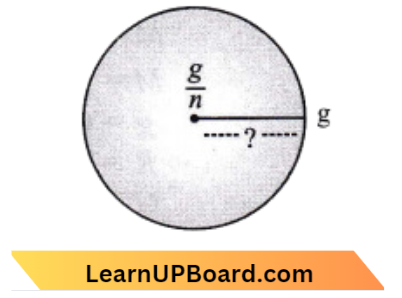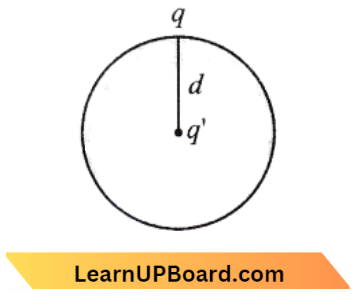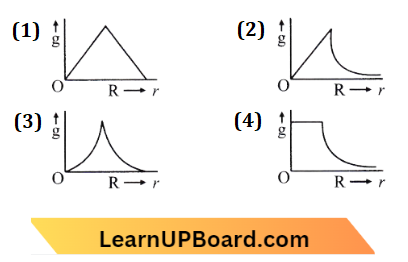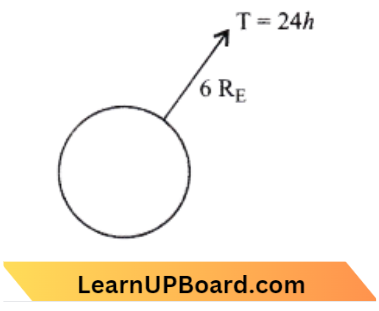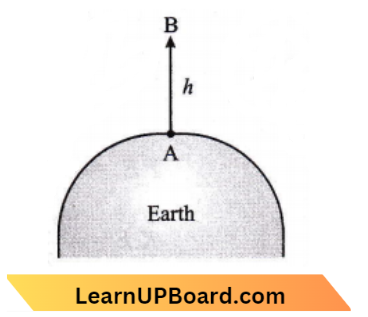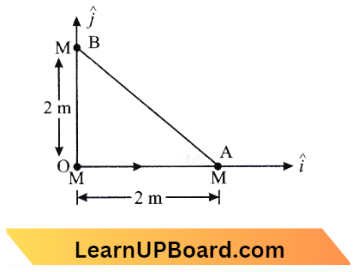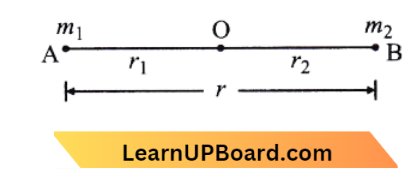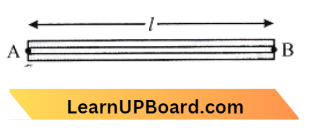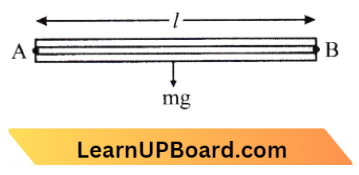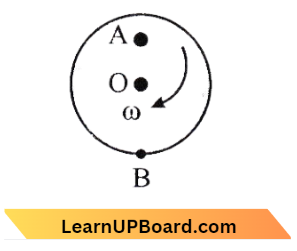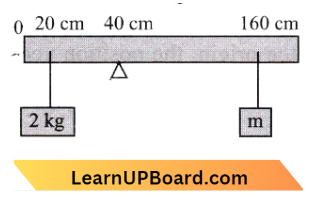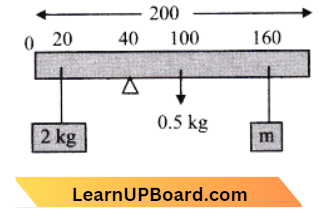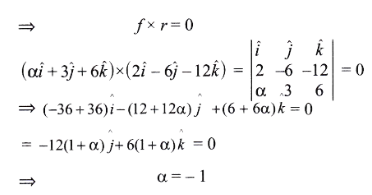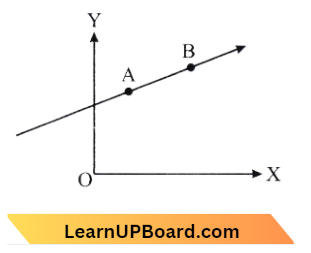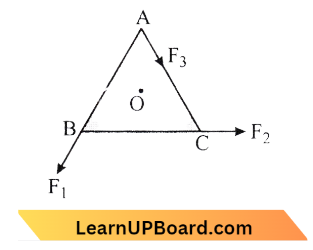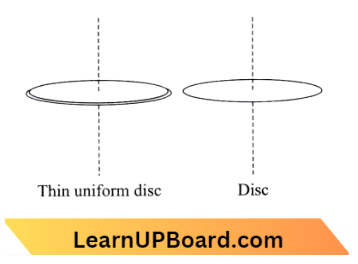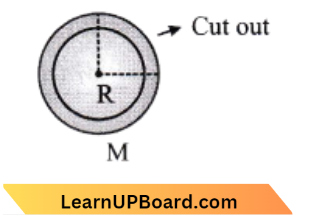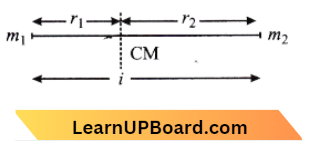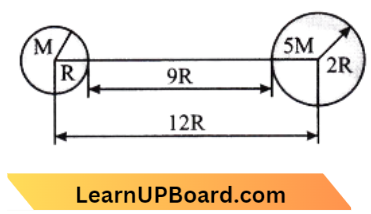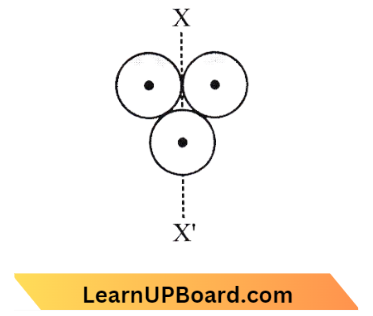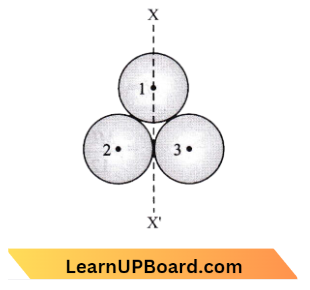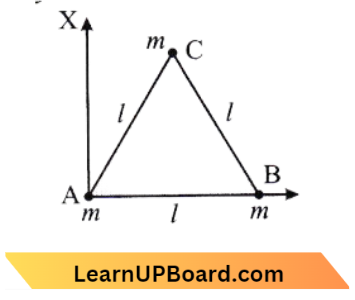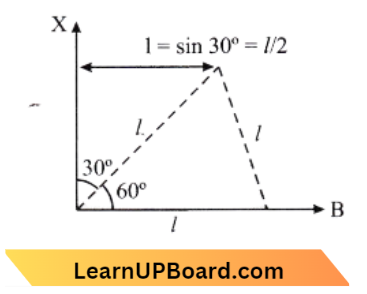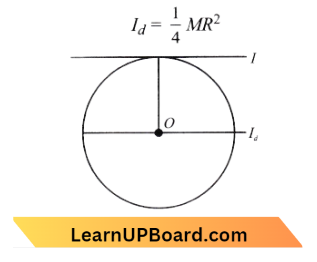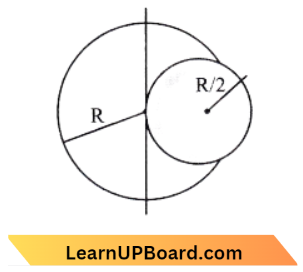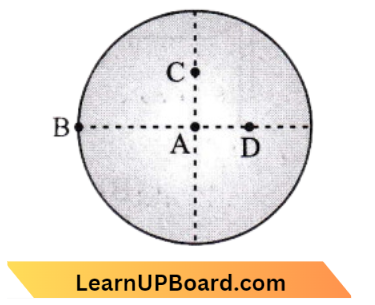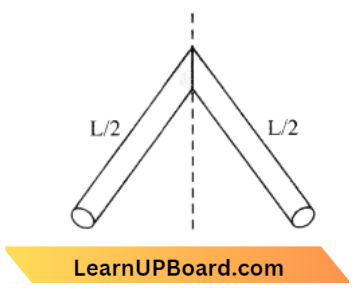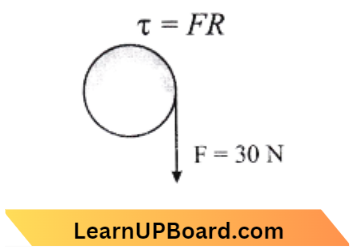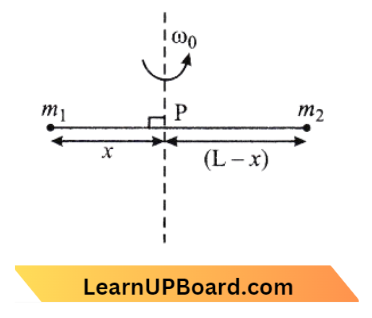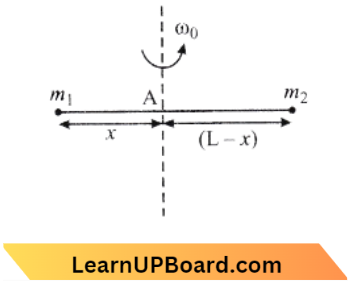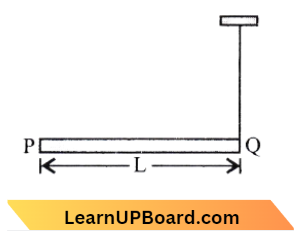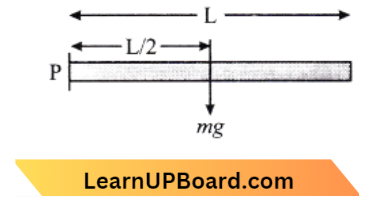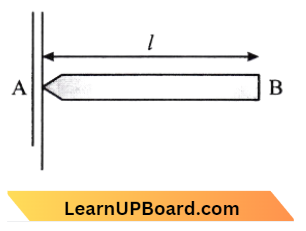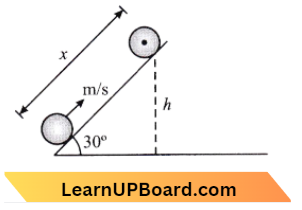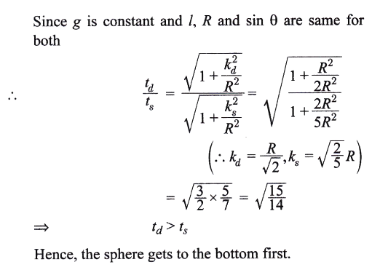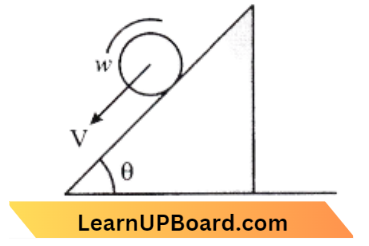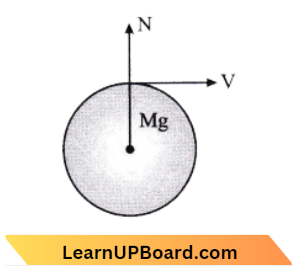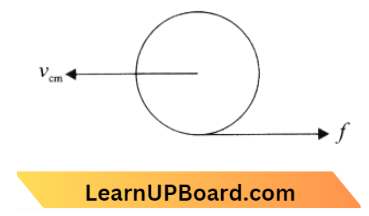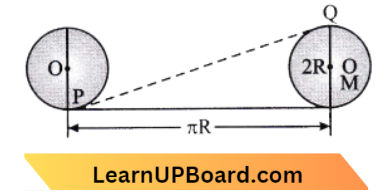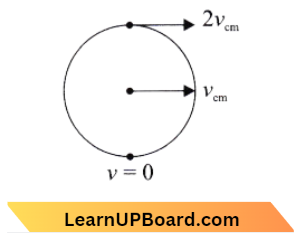NEET Physics For Electrostatic Potential And Capacitance Multiple Choice Questions
Question 1. In a certain region of space with a volume of 0.2 m3, the electric potential is found to be 5 V throughout. The magnitude of the electric field in this region is:
- 0.5 N/C
- 1 N/C
- 5 N/C
- zero
Answer: 1. 0.5 N/C
Given Volume, V=0.2 \(\mathrm{~m}^3\)
Electric potential =5 \(\mathrm{~V}\) (constant)
Electric field =?
Here Electric field, E=\(-\frac{d v}{d r}\)
Here V=5\(\mathrm{~V}\) and constant
E=\(-\frac{d(5)}{d t}\)
= \(\frac{d(\text { constant })}{d t}\)=0
Question 2. A bullet of mass 2 g is having 2 μc. Through what potential difference must it be accelerated, starting from rest, to acquire a speed of 10 m/s?
- 5 kV
- 50 kV
- 5 V
- 50 V
Answer: 2. 50 kV
Here we apply, \(\frac{1}{2} m v^2\)=q V
V =\(\frac{1}{2} \times \frac{2 \times 10^{-3} \times 10 \times 10}{2 \times 10^{-6}}\)
=50 kV
Question 3. The variation of electrostatic potential with radial distance r from the centre of a positively charged metallic thin shell of radius R is given by the graph:
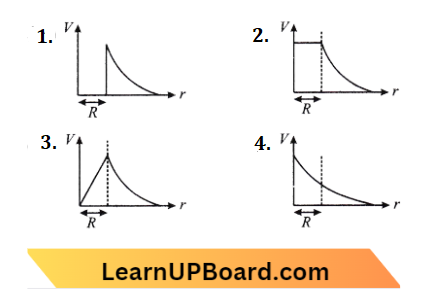
Answer: 3.
Since electric potential remains constant inside the metallic spherical shell which is the same as at the surface of a spherical shell. Outside the spherical shell V \(\propto \frac{1}{r}\). So, (b) is the r variation of potential (V) with distance r
Question 4. The electric potential at a point in free space due to charge Q coulomb is Q x 1011 V. The electric field at that point is:
- 4 \(\pi \varepsilon_0 \mathrm{Q} \times 10^{22} \mathrm{~V} / \mathrm{m}\)
- 12 \(\pi \varepsilon_0 \mathrm{Q} \times 10^{20} \mathrm{~V} / \mathrm{m}\)
- 4 \(\pi \varepsilon_0 \mathrm{Q} \times 10^{22} \mathrm{~V} / \mathrm{m}\)
- 12 \(\pi \varepsilon_0 \mathrm{Q} \times 10^{22} \mathrm{~V} / \mathrm{m}\)
Answer: 1. 4 \(\pi \varepsilon_0 \mathrm{Q} \times 10^{22} \mathrm{~V} / \mathrm{m}\)
Since, V =\(\frac{Q}{4 \pi \varepsilon_0 r}\)
Given, V =\(Q \times 10^{11}\)
r =\(\frac{1}{4 \pi \varepsilon_0 \times 10^{11}}\)
Now \(\mathrm{E} =\frac{V}{r}\)
E = \(Q \times 10^{11} \times 4 \pi \varepsilon_0 \times 10^{11}\)
= 4 \(\pi \varepsilon_0 \times 10^{22} \mathrm{~V} / m\)
Read and Learn More NEET Physics MCQs
Question 5. As per the diagram a point charge + q is placed at the origin O. Work done in taking another point charge – Q from the point A [coordinate (0, a)] to another point B [coordinates (a, 0)] along the straight path AB is:
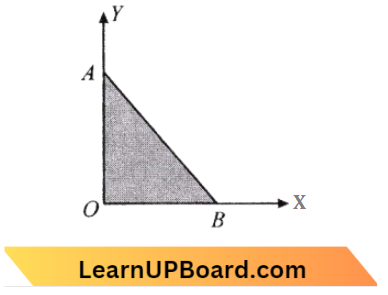
- zero
- \(\left(\frac{q Q}{4 \pi \varepsilon_0} \frac{1}{a^2}\right) \cdot \sqrt{2}\) a
- \(\left(\frac{-q Q}{4 \pi \varepsilon_0} \frac{1}{a^2}\right) \cdot \sqrt{2}\) a
- \(\left(\frac{q Q}{4 \pi \varepsilon_0} \frac{1}{a^2}\right) \cdot \frac{a}{\sqrt{2}}\)
Answer: 1. zero
Work done is equal to zero because the potential of A and B are the same \(\frac{1}{4 \pi \epsilon_0} \frac{q}{a}\)

No work is done if a particle does not change its potential energy.
The initial potential energy = final potential energy.
Question 6. A short electric dipole has a dipole moment of 16 x 10-9 cm. The electric potential due to the dipole at a point at a distance of 0.6 m from the centre of the dipole, situated on a line making an angle of 60° with the dipole axis is:\(\left(\frac{1}{4 \pi \varepsilon_0}=9 \times 10^9 \mathrm{Nm}^2 / \mathrm{C}^2\right)\)
- 200 V
- 400 V
- zero
- 50 V
Answer: 1. 200 V
Given the electric dipole moment,
P= \(16 \times 10^{-9} \mathrm{~cm}\)
Distance, r=0.6 \(\mathrm{~m}, Angle \theta=60^{\circ}\)
⇒ \(\cos 60^{\circ}=\frac{1}{2}\)
The Electric potential at a point at a distance k at some angle \(\theta\) from electric dipole is V and
V =\(\frac{P \cos \theta}{4 \pi \varepsilon_0 r^2}\)
= 9 \(\times 10^9 \times \frac{16 \times 10^{-9} \times \frac{1}{2}}{(0.6)^2}\)
= 2 \(\times 10^2=200 \mathrm{~V}\)
Question 7. Two hollow conducting spheres of radii R1 and R0 (R1>>R2) have equal charges. The potential would be:
- more on the bigger sphere
- more on the smaller sphere
- equal on both the spheres
- dependent on the material property of the sphere
Answer: 2. more on the smaller sphere
For a hollow sphere, an electric potential is \(\mathrm{V}=\frac{\mathrm{kq}}{\mathrm{R}}\)
For sphere 1, \(V_1=\frac{k q}{R_1}\)
For sphere 1, \(V_2=\frac{k q}{R_2}\)
As \(\mathrm{R}_1 \gg \mathrm{R}_2\),
⇒ \(\mathrm{V}_1 \ll \mathrm{V}_2\).
So, the potential is more on the smaller sphere.
Question 8. Two charged spherical conductors of radius R1 and R2 are connected by a wire. Then the ratio of surface charge densities of the spheres \((\sigma_1 / \sigma_2)\) is:
- \(\frac{R_1}{R_2}\)
- \(\frac{R_2}{R_1}\)
- \(\sqrt{\left(\frac{R_1}{R_2}\right)}\)
- \(\frac{R_1^2}{R_2^2}\)
Answer: 2. \(\frac{R_2}{R_1}\)
Given,Radius =\(R_1 \text { and } R_2 \)
Surface density =\(\sqrt{\sigma_1} \text { and } \sqrt{\sigma_2}\)
⇒ \(\mathrm{~V}_1=\mathrm{V}_2\)
⇒ \(\frac{k q_1}{\mathrm{R}_1}=\frac{k q_2}{\mathrm{R}_2} \)
⇒ \(\frac{q_1}{q_2}=\frac{R_1}{R_2}\) → Equation 1
Since the spheres are connected by wire. Hence, the charge on them will be equal.
⇒ \(q_1 =q_2\)
⇒ \(q_1 =\sigma_1 \mathrm{~A}_1, q_2=\sigma_2 \mathrm{~A}_2\)
⇒ \(q_1 =\sigma_1 4 \pi \mathrm{R}_1^2\)
⇒ \(q_2 =\sigma_2 4 \pi \mathrm{R}_2^2\)
⇒ \(\frac{\sigma_1}{\sigma_2} =\frac{\frac{q_1}{4 \pi \mathrm{R}_1^2}}{\frac{q_2}{4 \pi \mathrm{R}_2^2}}\)
∴ \(\frac{\sigma_1}{\sigma_2} =\frac{\mathrm{R}_2^2}{\mathrm{R}_1^2} \times \frac{\mathrm{R}_1}{\mathrm{R}_2}=\frac{\mathrm{R}_2}{\mathrm{R}_1}\)
Question 9. Twenty-seven drops of the same size are charged at 220 V each. They combine to form a bigger drop. The potential for a bigger drop is:
- 660 V
- 1320 V
- 1520 V
- 1980 V
Answer: 4. 1980 V
Given, the No. of drops = 27
Radius = r
Voltage (F)= 220 V
Its total Radius = R
V=?
Bigger sphere volume \(V_B=\frac{4}{3} \pi \mathrm{R}^3\)
Smaller sphere volume \(V_{\mathrm{s}}=\frac{4}{3} \pi r^3\)
⇒ \(27 \frac{4}{3} \pi r^3 =\frac{4}{3} \pi \mathrm{R}^3 \)
⇒ \(27 r^3 =\mathrm{R}^3\)
⇒ \(\mathrm{R} \) =3 r
Charge \(q_1\) on smaller sphere,
⇒ \(\mathrm{V}_0=\frac{q}{4 \pi \varepsilon_0 r}\)
⇒ \(q_1=\mathrm{V}_0 4 \pi \varepsilon_0 r\)
Charge \(q_2\) on bigger sphere,
⇒ \(q_2 =27 q_1\)
∴ \(\mathrm{V} =\frac{q_2}{4 \pi \varepsilon_0 \mathrm{R}}\)
Question 10. Two metal spheres, one of radius R and the other of radius 2R respectively have the same surface charge density \(\sigma\). They are brought in contact and separated. The new charge densities on them will be:
- \(\sigma_1=\frac{5}{6} \sigma, \sigma_2=\frac{5}{2} \sigma\)
- \(\sigma_1=\frac{5}{2} \sigma, \sigma_2=\frac{5}{6} \sigma\)
- \(\sigma_1=\frac{5}{2} \sigma, \sigma_2=\frac{5}{3} \sigma\)
- \(\sigma_1=\frac{5}{3} \sigma, \sigma_2=\frac{5}{6} \sigma\)
Answer: 4. \(\sigma_1=\frac{5}{3} \sigma, \sigma_2=\frac{5}{6} \sigma\)
Given
Two metal spheres, one of radius R and the other of radius 2R respectively have the same surface charge density \(\sigma\). They are brought in contact and separated.
⇒ \(\sigma_1=\frac{5}{3} \sigma, \sigma_2=\frac{5}{6} \sigma\)
We know that surface charge density
⇒ \(\sigma=\frac{q}{A}=\frac{q}{4 \pi R^2}\)
q= \(\sigma .4 \pi R^2\)
Before contact of both the spheres X and Y.

For X, \(q_1 =\sigma .4 \pi R^2 \)
⇒ \(q_2 =4 q_1\)
After Contact, \(q_2=\sigma .4 \pi(2 R)^2\)
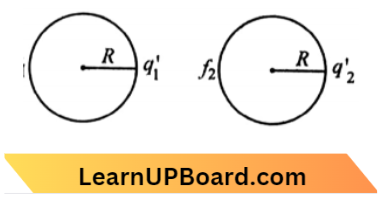
Here \(\sigma_1=\frac{q_1^{\prime}}{4 \pi R^2}\) and
⇒ \(\sigma_2=\frac{q_2^{\prime}}{4 \pi R\left(2 R^2\right)}\)
Again we know that, V=\(\frac{k q}{\mathrm{R}}\)
So, \(\frac{k q_1^{\prime}}{\mathrm{R}}=\mathrm{K}\)
So, after contact, we can say, \(q_1^{\prime}+q_2^{\prime}=q_1+q_2=5 q_1 \)
⇒ \(q_1{ }^{\prime}+q_2{ }^{\prime}=5 \times \sigma 4 \pi \mathrm{R}^2\)
3 \(q_1^{\prime}=5 \times 6 \times 4 \pi \mathrm{R}^2 \)
3 \(q_1^{\prime}=5 \times 6 \times 4 \pi \mathrm{R}^2 \)
and \(q_2^{\prime}=2 q_1^{\prime}=\frac{10}{3} \times \sigma 4 \pi \mathrm{R}^2\)
Putting the value of \(q_1{ }^{\prime} and q_2\)
∴ \(\sigma_1=\frac{5}{3} \sigma \text { and } \sigma_2=\frac{5}{6} \sigma\)
Question 11. Four point charges -Q, – q, 2q and 2Q are placed, one at each corner of the square. The relation between Q and q for which the potential at the centre of the square is zero, is:
- Q=-q
- Q=\(-\frac{1}{q}\)
- Q=q
- Q=\(\frac{1}{q}\)
Answer: 1. Q=-q
According to the question when the potential at the centre is zero,
⇒ \(V_1+V_2+V_3+V_4\)=0
⇒ \(\frac{\mathrm{KQ}}{r}-\frac{\mathrm{K} q}{r}+\frac{\mathrm{K}(2 \mathrm{Q})}{r}+\frac{\mathrm{K} 2 q}{r}\) =0
⇒ \(-Q-q+2 q+2 Q \)=0
Q =\(-\mathrm{q}\)
Question 12. Four electric charges + q, + q, – q and – q are placed at the comers of a square of side 2L (see figure). The electric potential at point A mid-way between the two charges + q and q, is:
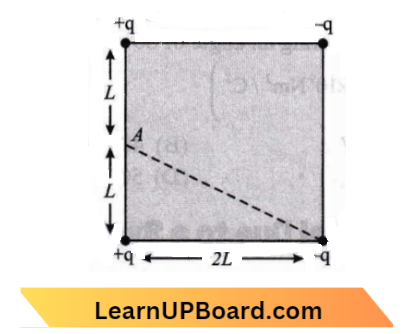
- \(\frac{1}{4 \pi \varepsilon_0} \frac{2 q}{L}\left(1+\frac{1}{\sqrt{5}}\right)\)
- \(\frac{1}{4 \pi \varepsilon_0} \frac{2 q}{L}\left(1-\frac{1}{\sqrt{5}}\right)\)
- zero
- \(\frac{1}{4 \pi \varepsilon_0} \frac{2 q}{L}(1+\sqrt{5})\)
Answer: 2. \(\frac{1}{4 \pi \varepsilon_0} \frac{2 q}{L}\left(1-\frac{1}{\sqrt{5}}\right)\)
⇒ \(V_A =\frac{k q}{L}+\frac{k q}{L}-\frac{k q}{\sqrt{5} L}-\frac{k q}{\sqrt{5} L}\)
= \(\frac{2 k q}{L}\left(1-\frac{1}{\sqrt{5}}\right)\)
= \(\frac{2 q}{L} \times \frac{1}{4 \pi \varepsilon_0}\left(1-\frac{1}{\sqrt{5}}\right)\)
Question 13. Three charges, each + q, are placed at the comers of an isosceles triangle ABC of sides BC and AC, 2a. D and E are the mid j oint of BC and CA. The work done in taking a charge Q from D to E is:
- \(\frac{q Q}{8 \pi \varepsilon_0 a}\)
- \(\frac{q \mathrm{Q}}{4 \pi \varepsilon_0 a}\)
- zero
- \(\frac{3 q Q}{4 \pi \varepsilon_0 a}\)
Answer: 3. zero
Given
Three charges, each + q, are placed at the comers of an isosceles triangle ABC of sides BC and AC, 2a. D and E are the mid j oint of BC and CA
The situation is shown in the diagram,
From the figure, A C =\(B C(\text { given })\)
⇒ \(V_D =V_E\)=V
W =\(Q\left(V_{\mathrm{E}}-V_{\mathrm{D}}\right)\)
=Q(V-V)
W = 0
Question 14. Three concentric spherical shells have radii a, b and c (a< b <c) and have surface charge densities a, – a and o respectively. If VA, VB and VC denote the potentials of the three shells then for c = a + b, we have:
- \(V_C=V_A \neq V_B\)
- \(V_C=V_B \neq V_A\)
- \(V_C \neq V_B \neq V_A\)
- \(V_C=V_B=V_A\)
Answer: 1. \(V_C=V_A \neq V_B\)
⇒ \(V_A=\frac{1}{4 \pi \varepsilon_0}\left\{\frac{q_A}{a}+\frac{q_B}{b}+\frac{q_C}{c}\right\}\)

=\(\frac{4 \pi}{4 \pi \varepsilon_0}\left\{\frac{a^2 \sigma}{a}-\frac{b^2 \sigma}{b}+\frac{c^2 \sigma}{c}\right\}\)
⇒ \(V_A =\frac{1}{\varepsilon_0}\left\{\frac{a^2 \sigma}{a}-\frac{b^2 \sigma}{b}+\frac{c^2 \sigma}{c}\right\}\)
⇒ \(V_B =\frac{1}{\varepsilon_0}\left\{\frac{a^2 \sigma}{b}-\frac{b^2 \sigma}{b}+\frac{c^2 \sigma}{c}\right\}\)
⇒ \(V_C =\frac{1}{\varepsilon_0}\left\{\frac{a^2 \sigma}{c}-\frac{b^2 \sigma}{c}+\frac{c^2 \sigma}{c}\right\}\)
Using c=a+b, \(V_A=\frac{2 a \sigma}{\varepsilon_0} \)
⇒ \(V_B =\frac{\sigma}{\varepsilon_0}\left(\frac{a^2}{b}+a\right)=\frac{\sigma}{\varepsilon_0} \frac{a c}{b}\)
⇒ \(V_C \frac{\sigma}{\varepsilon_0}\left[\frac{(a+b)(a-b)}{c}+c\right]\)
= \(\frac{\sigma}{\varepsilon_0}(a-b+c)=\frac{2 a \sigma}{\varepsilon_0} \)
⇒ \(V_B =\frac{1}{4 \pi \varepsilon_0} \frac{\sigma 4 \pi c^2}{b}-\frac{1}{4 \pi \varepsilon_0} \frac{\sigma 4 \pi c^2}{b}\)
= \(\frac{\sigma}{\varepsilon_0}\left(\frac{a^2}{b}-b+c\right)\)
Similarly, \(V_C =\frac{\sigma}{\varepsilon_0}(2 a)\)
∴ \(V_A =V_C \neq V_B\)
Question 15. Two concentric spheres of radii R and r have similar charges with equal surface charge densities (o). What is the electric potential at their common centre?
- \(\frac{\sigma}{\varepsilon_0}\)
- \(\frac{\sigma}{\varepsilon_0}(R-r)\)
- \(\frac{\sigma}{\varepsilon_0}(R+r)\)
- None of these
Answer: 3. \(\frac{\sigma}{\varepsilon_0}(R+r)\)
Let the charges on the spheres be Q and q respectively. The potential at the common center,
V =\(\frac{1}{4 \pi \varepsilon_0}\left(\frac{Q}{R}\right)+\frac{1}{4 \pi \varepsilon_0}\left(\frac{q}{r}\right)\)
= \(\frac{1}{\varepsilon_0}\left[\frac{Q}{4 \pi R^2} \times R+\frac{q}{4 \pi r^2} \times r\right]\)
But, \(\frac{Q}{4 \pi R^2} =\frac{q}{4 \pi R^2}=\sigma\)
⇒ \(\mathrm{V} =\frac{1}{\varepsilon_0}[\sigma R+\sigma r]\)
=\(\frac{\sigma}{\varepsilon_0}(R+r)\)
Question 16. The angle between the electric lines of force and the equipotential surface is:
- 0°
- 45°
- 90°
- 180°
Answer: 3. 90°
The angle between the electric lines of force and the equipotential surface is 90°.
Question 17. The diagrams below show regions of equipotentials: A positive charge is moved from A to B in each diagram.
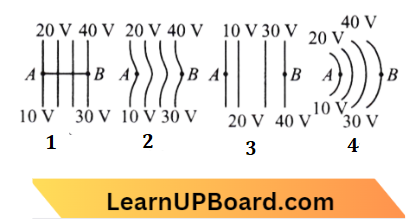
- Maximum work is required to move q in Figure (3).
- In all four cases, the work done is the same.
- Minimum work is required to move q in Figure (1).
- Maximum work is required to move q in Figure (2).
Answer: 2. In all the four cases, the work done is the same.
Work done, W = q \(\Delta V\)
∴ \(\Delta V\) is the same in all the cases so the work done is the same in all the cases.
Question 18. If potential (in volts) in a region is expressed as V(x, y, z) = 6xy -y + 2yz. the electric field in (N/C) at point (1,1, 0) is:
- \(-(3 \hat{i}+5 \hat{j}+3 \hat{k})\)
- \(-(6 \hat{i}+5 \hat{j}+2 \hat{k})\)
- \(-(2 \hat{i}+3 \hat{j}+\hat{k})\)
- \(-(6 \hat{i}+9 \hat{j}+\hat{k})\)
Answer: 2. \(-(6 \hat{i}+5 \hat{j}+2 \hat{k})\)
From the question, Potential in a region,
⇒ \(V_{(x, y, z)}=6 x y-y+2 y z\)
Electric field, E= \(-\frac{\partial V}{\partial x} \hat{i}-\frac{\partial V}{\partial y} \hat{j}-\frac{\partial V}{\partial z} \hat{k}\)
= \(-6 y \hat{i}-(6 x-1) \hat{j}-2 y \hat{k}\)
⇒ \(E_{(1,1,0)} =(6 \times 1) \hat{i}-(6 \times 1-1) \hat{j}-2 \times 1 \hat{k}\)
= \(-(6 \hat{i}+5 \hat{j}+2 \hat{k}) \mathrm{N} / \mathrm{C}\)
Question 19. In a region the potential is represented by V(x, y, z) = 6x – xy – 8y + 6yz, where V is in volts and x, y, z are in metres. The electric force experienced by a charge of 2 coulomb situated at point (1, 1,1) is:
- \(6 \sqrt{5} \mathrm{~N}\)
- 30 \(\mathrm{~N}\)
- 24 \(\mathrm{~N}\)
- 4 \(\sqrt{35} \mathrm{~N}\)
Answer: 4. 4 \(\sqrt{35} \mathrm{~N}\)
It is given,
V=6 x-8 x y-8 y+6 y z
We know that, E =\(\frac{\mathrm{d} V}{\mathrm{~d} x}\) → Equation 1
⇒ \(E_X =\frac{\mathrm{d} V}{\mathrm{~d} x}=6-8 y \)
⇒ \(E_Y =\frac{\mathrm{d} V}{\mathrm{~d} y}=-8 x-8+6 \mathrm{z}\) → Equation 2
⇒ \(E_{\mathrm{z}} =\frac{d V}{d z}\)=6 y
The values of \(E_X, E_Y\) and \(E_Z\) at (1,1,1) are,
⇒ \(E_X =6-8 \times 1\)=-2
⇒ \(E_Y =-8 \times 1-8+6 \times 1\)=-10
⇒ \(E_Z =6 \times 1\)=6
⇒ \(E_{\text {net }} =\sqrt{(2)^2+(10)^2+(6)^2}\)
=\(\sqrt{4+100+36}=\sqrt{140} \)
=\(\sqrt{35 \times 4}=2 \sqrt{35} \mathrm{~N} / \mathrm{C}\)
F =\(q \cdot E_{n e t}\)
=\(2 \times(2 \sqrt{35})=4 \sqrt{35} \mathrm{~N}\)
Question 20. The electric potential V at any points (x, y, z), all in metres in spaces is given V = 4×2 volt. The electric field at the point (1, 0, 2) in volt/metre is:
- 8 along the positive X-axis
- 16 along the negative X-axis
- 16 along the positive X-axis
- 8 along the negative X-axis
Answer: 4. 8 along the negative X-axis
It is given that, V=4 x^2
Then We have,E =\(-\left[\hat{i} \frac{\partial V}{\partial x}+\hat{j} \frac{\partial V}{\partial y}+\hat{k} \frac{\partial V}{\partial z}\right]\)
= \(\hat{i} \frac{\partial V}{\partial x}=-\hat{i} \frac{\partial V}{\partial x}\left(4 x^2\right)\)
= \(-8 x \mathrm{Vm}^{-2}\)
∴ \(\mathrm{E}_{(1,0,2)} =-8 \times 1=-8 \hat{i} \cdot \mathrm{Vm}^{-1}\)
Question 21. The electric potential at a point (x, y, z) is given by, \(V=-x^2 y-x z^3+4\). The electric field \(\vec{E}\) at that point is:
- \(\vec{E}=\left(2 x y+z^3\right) \hat{i}+x^2 \hat{j}+3 x z^2 \hat{k}\)
- \(\vec{E}=2 x y \hat{i}+\left(x^2+y^2\right) \hat{j}+\left(3 x z-y^2\right) \hat{k}\)
- \(\vec{E}=z^3 \hat{i}+x y z \hat{j}+z^2 \hat{k}\)
- \(\vec{E}=\left(2 x y-z^3\right) \hat{i}+x y^2 \hat{j}+3 z^2 x \hat{k}\)
Answer: 1. \(\vec{E}=\left(2 x y+z^3\right) \hat{i}+x^2 \hat{j}+3 x z^2 \hat{k}\)
We know that, E =\(-\frac{d V}{d r}=\left[-\frac{\partial v}{\partial x} \hat{i}-\frac{\partial v}{\partial y} \hat{j}-\frac{\partial v}{\partial z} \hat{k}\right]\)
= \(\left[\hat{i}\left(2 x y+z^3\right)+\hat{j} x^2+\hat{k} 3 x z^2\right]\)
Question 22. Charges +q and -q are placed at points A and B respectively which are a distance 2L apart, C is the midpoint between A and B. The work done in moving a charge +Q along the semicircle CRD is:
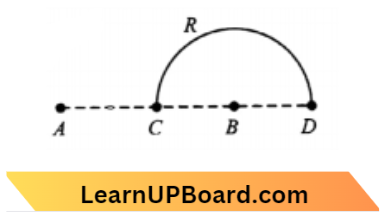
- \(\frac{q Q}{2 \pi \varepsilon_0 L}\)
- \(\frac{q Q}{6 \pi \varepsilon_0 L}\)
- \(\frac{q Q}{3 \pi \varepsilon_0 L}\)
- \(\frac{q Q}{4 \pi \varepsilon_0 L}\)
Answer: 2. \(\frac{q Q}{6 \pi \varepsilon_0 L}\)
W=\(\Delta U=\mathrm{Q}\left(V_D-V_C\right)\)
where, \(V_C\)=0
W =\(Q\left[\frac{q}{4 \pi \varepsilon_0(3 L)}-\frac{q}{4 \pi \varepsilon_0(L)}\right]\)
= \(-\frac{Q q}{6 \pi \varepsilon_0 L}\)
The potential at C is zero because the charges are equal and opposite and the distances are the same. Potential at D due to – q is greater than that at A (+q) because D is closer to B.
∴ It is negative.
Question 23. Two charges q1 and q2 are placed 30 cm apart, as shown in the figure. A third charge q3 is moved along the arc of a circle of radius 40 cm from C to D. The change in the potential energy of the system is \(\frac{V_3}{4 \pi \varepsilon_0} k\)
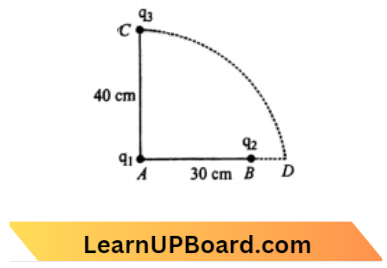
- \(8 q_1\)
- \(6 q_1\)
- \(8 q_2\)
- \(6 q_2\)
Answer: 3. \(8 q_2\)
⇒ \(V_i=\frac{1}{4 \pi \epsilon_0}\left[\frac{q_1 q_3}{(0.4)}+\frac{q_1 q_2}{(0.3)}+\frac{q_2 q_3}{(0.5)}\right] \)
\(V_f=\frac{1}{4 \pi \epsilon_0}\left[\frac{q_1 q_3}{(0.4)}+\frac{q_1 q_2}{(0.3)}+\frac{q_2 q_3}{(0.1)}\right]\)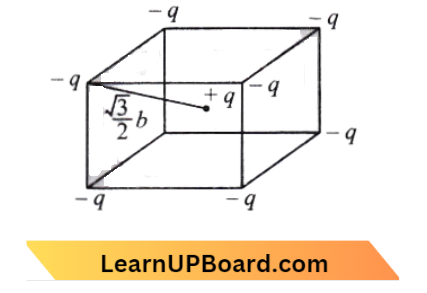
⇒ \(\Delta V =V_f-V_{\mathrm{i}}\)
= \(\frac{1}{4 \pi \epsilon_0} q_2 q_3\left(\frac{1}{0.1}-\frac{1}{0.5}\right)\)
= \(\frac{q_2 q_3}{4 \pi \epsilon_0}\left(10^{-2}\right)\)
= \(\frac{q_3}{4 \pi \epsilon_0}\left(8 q_2\right)\)
k =\(8 q_2\)
Question 24. Identical charges (- q) are placed at each comer of a cube of side ‘b’ then the electrical potential energy of charge (+ q) which is placed at the centre of the cube will be:
- \(\frac{-4 \sqrt{2} q^2}{\pi \varepsilon_0 b}\)
- \(\frac{-8 \sqrt{2} q^2}{\pi \varepsilon_0 b}\)
- \(\frac{-4 q^2}{\sqrt{3} \pi \varepsilon_0 b}\)
- \(\frac{8 \sqrt{2} q^2}{4 \pi \varepsilon_0 b}\)
Answer: 3. \(\frac{-4 q^2}{\sqrt{3} \pi \varepsilon_0 b}\)
The distance between the charge -q and +q is,
r= \(\sqrt{\frac{(\sqrt{2} b)^2+(b)^2}{2}}=\frac{\sqrt{3}}{2} b\)
The electric potential energy of charge +q is,
V = 8 \(\times \frac{1}{4 \pi \varepsilon_0} \frac{q(-q)}{r}\)
= 8 \(\times \frac{1}{4 \pi \varepsilon_0} \frac{q(-q)}{\frac{\sqrt{3}}{2} b}\)
U =\(\frac{-4 q^2}{\sqrt{3} \pi \varepsilon_0 b}\)
Question 25. In bringing an electron towards another electron, the electrostatic potential energy of the system:
- decreases
- increases
- remains same
- becomes zero
Answer: 2. increases
The electron is charged negatively. When an electron passes another electron, the same negative charges produce a repulsive force between them. As a result, work is done against this repulsive force to bring them closer together. Electrostatic potential energy is used to store the work.
As a result, the system’s electrostatic potential energy increases. Since the electrostatic potential energy of a system of two electrons, \(\mathrm{U}=\frac{1}{4 \pi \varepsilon_0} \frac{(-e)(-e)}{r}=\frac{1}{4 \pi \varepsilon_0} \frac{e^2}{r}\)
R decreases, and potential energy U increases.
Question 26. A dipole is placed in an electric field as shown. In which direction will it move?
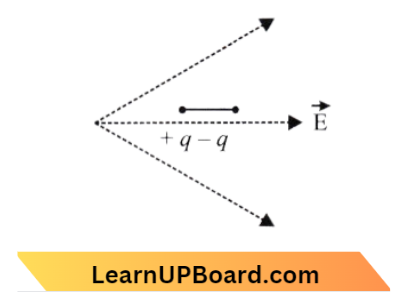
- Towards the left, its potential energy will increase.
- Towards the right, its potential energy will decrease.
- Towards the left, its potential energy will decrease.
- Towards the right, its potential energy will increase.
Answer: 3. Towards the left its potential energy will decrease.
Since the electric field is growing against the dipole direction hence the dipole will move towards the left due to a decrease in its potential energy.
Question 27. An electric dipole of dipole moment p is aligned parallel to a uniform electric field E. The energy required to rotate the dipole by 90° is:
- \(p^2 E\)
- pE
- infinity
- \(p E^3\)
Answer: 2. pE
The potential energy of the dipole
U = \(-p E\left(\cos \theta_2-\cos \theta_1\right)\)
⇒ \(\theta_2 =0^{\circ}\)
=\(-p E\left(\cos 90^{\circ}-\cos 0^{\circ}\right)\)
U = PE
Question 28. An electric dipole of dipole moment \(\vec{p}\) is lying along a uniform electric field \(\vec{E}\). The work done in rotating the dipole by:
- pE
- \(\sqrt{2} p E\)
- pE / 2
- 2PE
Answer: 1. pE
Work done, W =\(\int_0^\theta P E \sin \theta d \theta \)
= P E\((1-\cos \theta)\)
Since, \(\theta=90^{\circ}\)
W =\(P E\left(1-\cos 90^{\circ}\right)\)
Q = PE
Question 29. An electric dipole has the magnitude of its charge as q and its dipole moment is p. It is placed in a uniform electric field E. If its dipole moment is along the direction of the field the force on it and its potential energy are respectively:
- 2 q.E and minimum
- q.E and p.E
- zero and minimum
- q.E and maximum
Answer: 3. Zero and minimum
Force on each charge, of dipole
⇒ \(\tilde{F}\)=p E
Total force = zero, they are in the opposite direction
⇒ \(\vec{P}\) and \(\vec{E}\) are parallel to each other
U=\(-\vec{P} \cdot \vec{E}\) is minimum.
Question 30. Some charge is being given to a conductor. Then, its potential:
- Is maximum at the surface
- Is maximum at the centre
- Is the same throughout the conductor
- Is maximum somewhere between the surface and the
Answer: 3. Is the same throughout the conductor
We know that inside the conductor F = 0.
So, the potential remains the same.
Question 31. The electrostatic force between the metal plates of an isolated parallel plate capacitance C having Q and area A is:
- proportional to the square root of the distance between the plates.
- linearly proportional to the distance between the plates.
- independent of the distance between the plates.
- inversely proportional to the distance between the plates.
Answer: 3. independent of the distance between the plates.
We know that, For isolated capacitors, Q= constant
⇒ \(F_{\text {plate }}=\frac{Q^2}{2 A \varepsilon_0}\)
So, \(\mathrm{F}\) is independent of the distance between plates.
Question 32. A parallel plate air capacitor has capacity C, distance of separation between plates is d and potential difference V is applied between the plates. The force of attraction between the plates of the parallel plate air capacitor is:
- \(\frac{C^2 V^2}{2 d}\)
- \(\frac{C V^2}{2 d}\)
- \(\frac{C V^2}{d}\)
- \(\frac{C^2 V^2}{2 d^2}\)
Answer: 2. \(\frac{C V^2}{2 d}\)
According to question,F =\(\frac{Q^2}{2 \varepsilon_0 A} \)
Q =\(C V \text { and } C=\frac{\varepsilon_0 A}{d}\)
⇒ \(\varepsilon_0 A =c d\)
F =\(\frac{C^2 V^2}{2 C d}=\frac{C V^2}{2 d}\)
Question 33. A parallel plate air capacitor is charged to a potential difference of V volts. After disconnecting the charging battery the distance between the plates of the capacitor is increased using an insulating handle. As a result the potential difference between the plates:
- Increases
- decreases
- does not change
- becomes zero
Answer: 1. Increases
Given
A parallel plate air capacitor is charged to a potential difference of V volts. After disconnecting the charging battery the distance between the plates of the capacitor is increased using an insulating handle.
According to the question
⇒ \(\phi\)= Const and a decrease in C means an increase in V.
C =\(\frac{\varepsilon_0 A}{d}\)
Capacitance =\(\frac{\text { Charge }}{\text { Potential difference }}\)
Potential difference =\(\frac{\text { Charge }}{\text { Capacitance }}\) .
Question 34. A parallel plate capacitor having cross-sectional area A and separation d has air in between the plates. Now an insulating slab of the same area but thickness d/2 is inserted between the plates as shown in the figure having a dielectric constant (K = 4). The ratio of the new capacitance to its original capacitance will be:
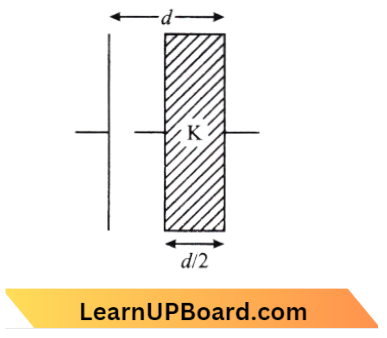
- 2: 1
- 8: 5
- 6: 5
- 4: 1
Answer: 2. 8: 5
Given
A parallel plate capacitor having cross-sectional area A and separation d has air in between the plates. Now an insulating slab of the same area but thickness d/2 is inserted between the plates as shown in the figure having a dielectric constant (K = 4).
The capacitance of parallel plate capacitor when the medium is air,
⇒ \(C_{\mathrm{o}}=\frac{\varepsilon_0 A}{d}\)
From \(2^{\text {nd }}\) condition,
⇒ \(A^{\prime}=A \cdot t=\frac{d}{2},\) k=4
v \(\mathrm{C}=\frac{\varepsilon_0 A}{(d-t)+\frac{t}{k}}=\frac{\varepsilon_0 \mathrm{~A}}{\left(d-\frac{d}{2}\right)+\frac{d / 2}{4}}\)
= \(\frac{\varepsilon_0 \mathrm{~A}}{\frac{d}{2}+\frac{d}{8}}=\frac{8}{5} \cdot \frac{\varepsilon_0 \mathrm{~A}}{d}\)
⇒ \(\frac{C}{C_0}=\frac{\frac{8}{5} \frac{\varepsilon_0 A}{d}}{\frac{\varepsilon_0 A}{d}}\)
∴ \(\frac{C}{C_0}=\frac{8}{5}\)
Question 35. The capacitance of a parallel plate capacitor with air as a medium is 6 pF. With the introduction of a dielectric medium, the capacitance becomes 30 pF. The permittivity of the medium is: \(\left(\varepsilon_0=8.85 \times 10^{-12} \mathrm{C}^2 \mathrm{~N}^{-1} \mathrm{~m}^{-2}\right)\)
- \(177 \times 10^{-12} \mathrm{C}^2 \mathrm{~N}^{-1} \mathrm{~m}^{-2}\)
- \(0.44 \times 10^{-12} \mathrm{C}^2 \mathrm{~N}^{-1} \mathrm{~m}^{-2}\)
- \(5.00 \mathrm{C}^2 \mathrm{~N}^{-1} \mathrm{~m}^{-2}\)
- \(0.44 \times 10^{-13} \mathrm{C}^2 \mathrm{~N}^{-1} \mathrm{~m}^{-2}\)
Answer: 2. \(0.44 \times 10^{-12} \mathrm{C}^2 \mathrm{~N}^{-1} \mathrm{~m}^{-2}\)
Given, \(C_{\mathrm{O}}=6 \mu F\)
⇒ \(C_M=30 \mu \mathrm{F}\)
Dielectric, K=\(\frac{C_M}{C_{\mathrm{O}}}=\frac{30}{6}\)=5
Dermittivity of medium, \(\varepsilon_m =K \times \varepsilon_0=5 \times \varepsilon_0\)
= 5 \(\times 8.854 \times 10^{-12}\)
= \(0.44 \times 10^{-12} \mathrm{C}^2 \mathrm{~N} \mathrm{~m}^{-2}\)
Question 36. Two thin dielectric slabs with dielectric constants K1 and K2(K1 < K2) are inserted between plates of a parallel plate capacitor, as shown in the figure. The variation of electric field E between the plates with distance d as measured from plate P is correctly shown by:
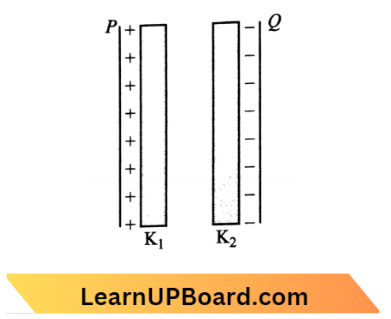
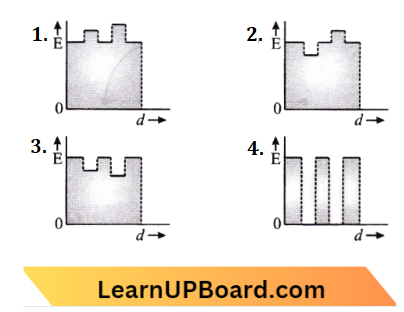
Answer: 2.
Given, the electric field inside the dielectrics will be less than the electric field outside the dielectrics. The electric field inside the dielectric could not be zero. Option (b) is the correct answer.
Question 37. Two parallel metal plates having charge + Q and – Q face each other at a certain distance between them. If the plates are now dipped in the kerosene oil tank, the electric field between the plates will:
- becomes zero
- increase
- decrease
- remain same
Answer: 3. decrease
Electric field in volume, \(E_0=\frac{\sigma}{2 \varepsilon_0}\)
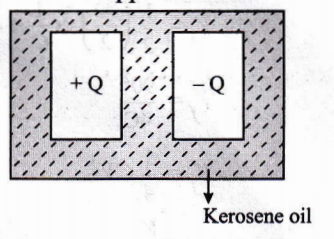
When plates are dipped in a kerosene oil electric field,
Here,E=\(\frac{\sigma}{2 \epsilon_0 \mathrm{~A}}\)
⇒ \(K<E_0\)
So the electric field between the plates will decrease.
Question 38. A parallel plate condenser with oil (dielectric constant 2) between the plates has capacitance C. If oil is removed, the capacitance of the capacitor becomes:
- \(\sqrt{2 C}\)
- 2C
- \(\frac{C}{\sqrt{2}}\)
- \(\frac{C}{2}\)
Answer: 4. \(\frac{C}{2}\)
We have, the capacitance of a parallel plate capacitor with dielectric (oil) between its plates is
⇒ \(\mathrm{C}=\frac{K \varepsilon_0 A}{d}\) → Equation 1
where, \(\varepsilon_0\)= electric permittivity of free space
K= dielectric constant of oil
A = Area of each plate of capacitor
d= distance between two plates
When the dielectric (oil) is removed, then, the capacitor’s capacitance will be,
⇒ \(\mathrm{C}_0=\frac{C}{K}=\frac{C}{2}\) → Equation 2
On comparing Eqs. (1) and (2), we get
⇒ \(C=K C_0 \)
∴ \(C_0=K C_0\)
Question 39. The equivalent capacitance of the combination shown in the figure is:
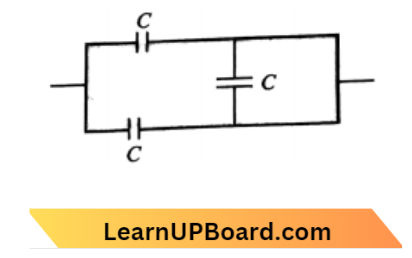
- 3C
- 2C
- \(\frac{C}{2}\)
- \(\frac{3 C}{2}\)
Answer: 2. 2C
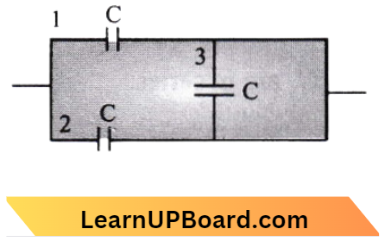
Since the capacitor (3) is shorted out by the parallel wire hence the net capacitance is in parallel.
∴ \(C_{\mathrm{P}}=C+C=2 C\)
Question 40. A parallel-plate capacitor of area A, plate separation d and capacitance C is filled with four dielectric materials having dielectric constants \(k_1, k_2, k_3, k_4\) as shown in the figure below. If a single dielectric material is to be used to have the same capacitance C in this capacitor, then its dielectric constant k is given by:
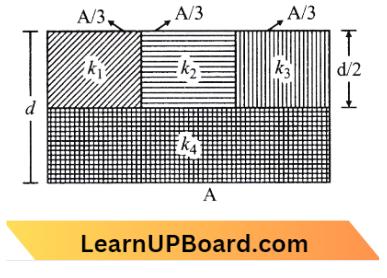
- \(k=k_1+k_2+k_3+3 k_4\)
- k=\(\frac{2}{k}\left(k_1+k_2+k_3\right)+2 k_4\)
- \(\frac{2}{k}=\frac{3}{k_1+k_2+k_3}+\frac{1}{k_4}\)
- \(\frac{1}{k}=\frac{1}{k_1}+\frac{1}{k_2}+\frac{1}{k_3}=\frac{3}{2 k_4}\)
Answer: 3. \(\frac{2}{k}=\frac{3}{k_1+k_2+k_3}+\frac{1}{k_4}\)
Here the capacitance, C=\(\frac{A k \varepsilon_0}{d}\)
The above three capacitors \(C_1, C_2, C_3\) are in parallel and then it is in series with \(C_4\).
Here, \(C_1=\frac{\left(\frac{A}{3}\right) k_1 \varepsilon_0}{\frac{d}{2}}=\frac{2 k_1}{3 k} C\)
⇒ \(C_2=\frac{\left(\frac{A}{3}\right) k_2 \varepsilon_0}{\frac{d}{2}}=\frac{2 k_2}{3 k} C\)
⇒ \(C_3=\frac{\left(\frac{A}{3}\right) k_3 \varepsilon_0}{\frac{d}{2}}=\frac{2 k_3}{3 k} C \)
⇒ \(C_4=\frac{\left(\frac{A}{3}\right) k_4 \varepsilon_0}{d}=\frac{2 k_4}{k} C\)
Now, the equivalent capacitance for the combination of four capacitors is
or \(\frac{1}{C_{e q}}=\frac{1}{C_1+C_2+C_3}+\frac{1}{C_4}\)
or \(\frac{1}{C}=\frac{3 k}{2 C}\left[\frac{1}{k_1+k_2+k_3}\right]+\frac{k}{2 k_4 C} (as C_{\text {eq }}=\mathrm{C} ) \)
or \(\frac{2}{k}=\frac{3}{k_1+k_2+k_3}+\frac{1}{k_4}\)
Question 41. Three capacitors each of capacitance C and of break-down voltage V are joined in series. The capacitance and breakdown voltage of the combination will be:
- \(\frac{C}{3}, \frac{V}{3}\)
- 3 C, \(\frac{V}{3}\)
- \(\frac{C}{3}\), 3 V
- 3 C, 3 V
Answer: 3. \(\frac{C}{3}\), 3 V
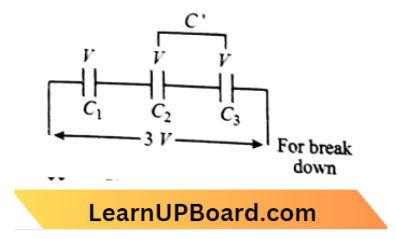
Here V=3 x
⇒ \(C_{e q}=\frac{1}{C_1}+\frac{1}{C_2}+\frac{1}{C_3}\)
∴ \(C_{e q}=\frac{C}{3}\)
Question 42. A network of four capacitors capacity equal C1 = C, C2= 2C, C3 = 3C and C4= 4C are conducted to a battery as shown in the figure. The ratio of the change on C2 and C4.
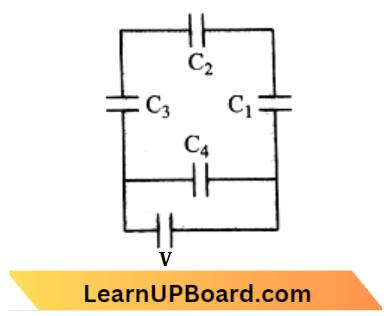
- \(\frac{4}{7}\)
- \(\frac{3}{22}\)
- \(\frac{7}{4}\)
- \(\frac{22}{3}\)
Answer: 2. \(\frac{3}{22}\)
Here, \(C_1, C_2, C_3\) are in series.

⇒ \(\frac{1}{C^{\prime}}=\frac{1}{C}+\frac{1}{2 C}+\frac{1}{3 C}\)
⇒ \(\frac{1}{C^{\prime}}=\frac{6+3+2}{6 C}=\frac{11}{6 C}\)
⇒ \(C^{\prime \prime}=\frac{6 C}{11}\)
All the capacitors in branch number 1 are in series so the charge on each number capacitor is:
⇒ \(Q^{\prime}=\frac{6}{11} C V\)
Also charge on capacitor \(C_4 is Q=4 \mathrm{~V}\)
Ratio =\(\frac{Q^{\prime}}{Q}=\frac{6 C V}{11 \times 4 C V} \)
= \(\frac{3}{22}\)
Question 43. Three capacitors each of capacity 4 \(\mu\)F are to be connected in such a way that the effective capacitance is 6 \(\mu\)F. This can be done by:
- connecting all of them in a series
- connecting them in parallel
- connecting two in series and one in parallel
- connecting two in parallel and one in series
Answer: 3. connecting two in series and one in parallel
⇒ \(\mathrm{C}_{\mathrm{AB}} =(2+4) \mu \mathrm{F}\)
=6 \(\mu \mathrm{F}\)
Question 44. A capacitor of capacitance C1 charged up to V volt and then connected to an uncharged capacitor C2. Then, the final potential difference across each capacitor will be:
- \(\frac{C_2 V}{C_1+C_2}\)
- \(\frac{C_1 V}{C_1+C_2}\)
- \(\left(1+\frac{C_2}{C_1}\right) V\)
- \(\left(1-\frac{C_2}{C_1}\right) V\)
Answer: 2. \(\frac{C_1 V}{C_1+C_2}\)
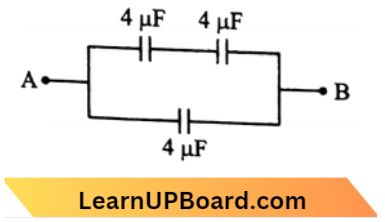
⇒ \(V^{\prime}=\frac{C_1 V_1+C_2 V_2}{C_1+C_2}\left( V_2=0\right)\)
∴ \(V^{\prime}=\frac{C_1 V_1}{C_1+C_2}\)
Question 45. A capacitor of capacitance C = 900 pF is charged fully by 100V battery B as shown in figure (1). Then it is disconnected from the battery and connected to another uncharged capacitor of capacitance C = 900 pF as shown in Fig (b). The electrostatic energy stored by the system (2) is:
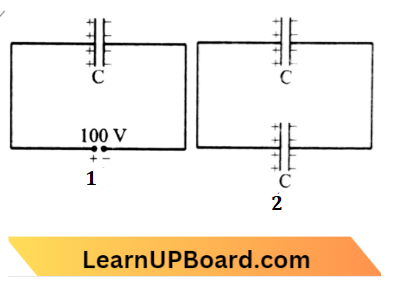
- \(4.5 \times 10^{-6} \mathrm{~J}\)
- 3.25 \(\times 10^{-6} \mathrm{~J}\)
- 2.25 \(\times 10^{-6} \mathrm{~J}\)
- 1.5 \(\times 10^{-6} \mathrm{~J}\)
Answer: 3. 2.25 \(\times 10^{-6} \mathrm{~J}\)
Given:
A capacitor of capacitance C = 900 pF is charged fully by 100V battery B as shown in figure (1). Then it is disconnected from the battery and connected to another uncharged capacitor of capacitance C = 900 pF as shown in Fig (b).
\(\mathrm{C}_1=\mathrm{C}_2=900 \mathrm{pF}\)⇒ \(\mathrm{V}_1=100 \mathrm{~V}, \mathrm{~V}_2=0 \mathrm{~V}\)
When \(\mathrm{C}_1 and \mathrm{C}_2\) are joined,
V =\(\frac{C_1 V_1+C_2 V_2}{C_1+C_2}\)
= \(\frac{900 \times 100+0}{1800}=50 \mathrm{~V}\)
Energy, U =\(\frac{1}{2}\left(C_1+C_2\right) V^2 \)
= \(\frac{1}{2} \times 1800 \times 10^{-12} \times 50 \times 50\)
= 2.25 \(\times 10^{-6} \mathrm{~J}\)
Question 46. A parallel plate capacitor has a uniform electric field ‘ E ’ in the space between the plates. If the distance between the plates is ‘d’ and the area of each plate is ‘A’, the energy stored in the capacitor is: (\(\varepsilon_0\) = permittivity of free space)
- \(\frac{1}{2} \varepsilon_0 E^2\)
- \(\varepsilon_0 E A d\)
- \(\frac{1}{2} \varepsilon_0 E^2 A d\)
- \(\frac{E^2 A d}{\mathrm{e}_0}\)
Answer: 3. \(\frac{1}{2} \varepsilon_0 E^2 A d\)
Given, Electric Field =E
Distance between plates =d
Area of plates =A
Energy =?
We know, \(\frac{\text { Energy }}{\text { Vol }}=\frac{1}{2} \varepsilon_0 E^2\)
Energy =\(\frac{1}{2} \varepsilon_0 E^2 \times \mathrm{Vol} \)
Energy =\(\frac{1}{2} \varepsilon_0 E^2 \mathrm{Ad}\)
Question 47. Two identical capacitors C1 and C2 of equal capacitance are connected as shown in the circuit. Terminals a and b of the key k are connected to charge capacitor C1 using a battery of emf V volt. Now, disconnecting a and b the terminals b and c are connected. Due to this, what will be the percentage loss of energy?
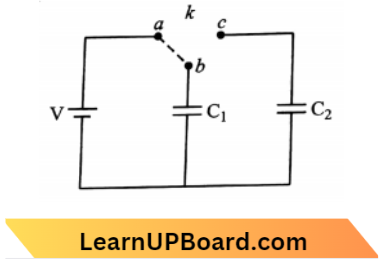
- 75%
- 0%
- 50%
- 25%
Answer: 3. 50%
Given
Two identical capacitors C1 and C2 of equal capacitance are connected as shown in the circuit. Terminals a and b of the key k are connected to charge capacitor C1 using a battery of emf V volt.
We know from the question,
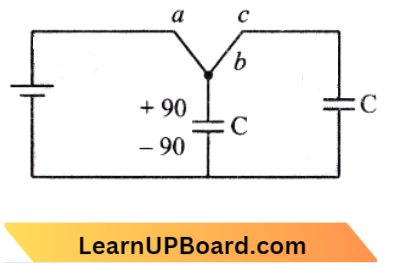
On switching key at point C, \(\frac{90-q}{\mathrm{C}} =\frac{q}{\mathrm{C}}\)
2 q =90
q =\(\left(\frac{90}{2}\right)\)
⇒ \(V_f =\frac{1}{2}\left(\frac{90}{2}\right)^2 \times \frac{1}{C}+\frac{1}{2} \times\left(\frac{90}{2}\right)^2 \times \frac{1}{C}\)
⇒ \(V_f =\frac{90^2}{4 \mathrm{C}}\)
⇒ \(V_f =\frac{1}{4} C V^2\)
⇒ \(\text { Loss }^2 =\frac{V_i-V_f}{V_i} \times 100\)
= \(\frac{\left(\frac{1}{2}-\frac{1}{4}\right) C V^2}{\frac{1}{2} C V^2} \times 100=50 \%\)
Question 48. A capacitor is charged by a battery. The battery is removed and another identical uncharged capacitor is connected in parallel. The total electrostatic energy of the resulting system:
- increases by a factor of 4
- decreases by a factor of 2
- remains the same
- increases by a factor of 2
Answer: 2. decreases by a factor of 2
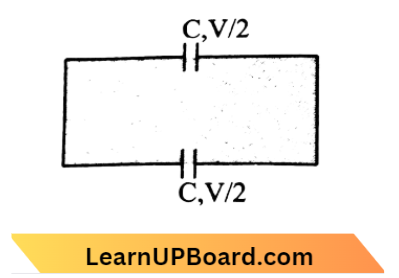
Change An Capacitor, q = CV
When it is connected to another uncharged capacity,
⇒ \(V_C=\frac{q_1+q_2}{C_1+C_2}=\frac{q+0}{C+C}=\frac{V}{2}\)
Initial energy, \(U_i=\frac{1}{2} C V^2\)
Final energy, \(U_f=\frac{1}{2} C\left(\frac{V}{2}\right)^2\)
= \(\frac{1}{2} C\left(\frac{V}{2}\right)^2=\frac{C V^2}{4}\)
Loss of energy, \(U_i-V_f=\frac{C V^2}{4}\)
∴ i.e. decreases by a factor of 2.
Question 49. A capacitor of 2 μF is charged as shown in the figure. When the switch S is turned to position 2, the percentage of its stored energy dissipated is:
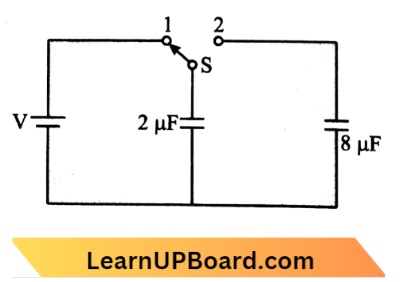
- 20%
- 75%
- 80%
- 0%
Answer: 3. 80%
First when switch S is connected to point 1. Then,
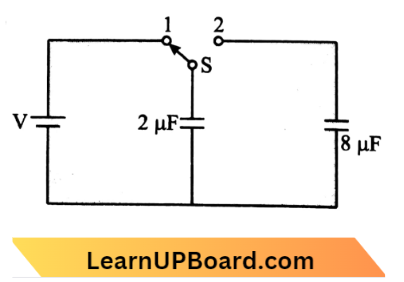
Initial energy stored in capacitor 2 \(\mu \mathrm{F}\) is,
⇒ \(U_i=\frac{1}{2}(2 \mu \mathrm{F}) V^2\left[Q E=\frac{1}{2} C V^2\right]\)
Second when switch S is connected to point 2, then
⇒ \(U_i=\frac{C_1 V_1}{C_1+C_2}=\frac{2 V}{10}=0.2 \mathrm{~V}\)
Final energy in both the capacitors,
⇒ \(\mathrm{U}_f =\frac{1}{2}\left(C_1+C_2\right) V_i^2 \)
=\(\frac{1}{2} \times 10\left(\frac{2 \mathrm{~V}}{10}\right)^2=0.2 \mathrm{~V}^2\)
So, energy dissipated = \(\frac{V^2-0.2 V^2}{V^2} \times 100=80 \%\)
Question 50. A parallel plate air capacitor of capacitance C is connected to a cell of emf V and then disconnected from it. A dielectric slab of electric constant K, which can just fill the air gap of the capacitor, is now inserted in it. Which of the following is incorrect?
- The potential difference between the plates decreases K times.
- The energy stored in the capacitor decreases K times.
- The energy stored in the capacitor decreases K times.
- The change on the capacitor is not conserved.
Answer: 4. The change on the capacitor is not conserved.
Let charge q on the capacitor (C) when connected to a cell of emf(V) is given by, q = CV
V=\(\frac{q}{C}\)
Energy stored is, U=\(\frac{1}{2} C V^2=\frac{q^2}{2 C}\)
When a dielectric slab of dielectric constant K is inserted, then a new capacitor \(C^{\prime}\) will be
V=\(\frac{q}{C^{\prime}}=\frac{q}{C K}\)
And energy stored is, \(U^{\prime}=\frac{q^2}{2 C K}\)
⇒ \(\Delta U=U-U\)
= \(\frac{q^2}{2 C}\left(\frac{1}{K}-1\right)\)
= \(\frac{1}{2} C V^2\left(\frac{1}{K}-1\right)\)
Question 51. The energy required to charge a parallel plate condenser of plate separation d and plate area of cross-section A such that the uniform electric field between the plates is E is:
- \(\frac{1}{2} \frac{\varepsilon_0 E^2}{A d}\)
- \(\frac{\varepsilon_0 E^2}{A d}\)
- \(\varepsilon_0 E^2 A d\)
- \(\frac{1}{2} \varepsilon_0 E^2 A d\)
Answer: 3. \(\varepsilon_0 E^2 A d\)
The energy given to the cell, E=\(C V^2\)
Where, C= capacitance of conductor =\(\frac{A \varepsilon_0}{d}\)
V= potential difference across the plate
E =\(\left(\frac{A \varepsilon_0}{d}\right)(E d)^2\)
=A \(\varepsilon_0 E^2 d\)
Question 52. Two condensers, one of capacity C and the other of capacity C/2 are connected to an F-volt battery, as shown. The work done in charging fully both the condensers is:

- \(\frac{1}{4} \mathrm{CV}^2\)
- \(\frac{3}{4} C V^2\)
- \(\frac{1}{2} C V^2\)
- \(2 \mathrm{CV}^2\)
Answer: 2. \(\frac{3}{4} C V^2\)
Work done in charging fully both the condensers,
⇒ \(\mathrm{W}=\mathrm{U}=\frac{1}{2} C V^2+\frac{1}{2}\left(\frac{C}{2}\right) V^2\)
v \(\mathrm{~W}=\mathrm{U}=\frac{3}{4} C V^2\)
Question 53. A capacitor is charged by connecting a battery across its plates. It stores energy U. Now the battery is disconnected and another identical capacitor is connected across it, then the energy stored by both capacitors of the system will be:
- U
- \(\frac{U}{2}\)
- 2U
- \(\frac{3}{2} U\)
Answer: 2. \(\frac{U}{2}\)
The initial energy held in a capacitor is released when it is charged by connecting a battery across its plates.\(U=\frac{q^2}{2 C}\)
The charge remains constant when the battery is disconnected, i.e. q = constant. Now, another identical capacitor is connected across it, forming a parallel connection. Thus, the equivalent capacitance.
⇒ \(C_{e q} =C_1+C_2 \)
=C+C=2 C
Final energy stored by the system of capacitors,
⇒ \(U^{\prime}=\frac{q^2}{2 C_{\mathrm{eq}}}\)
⇒ \(U^{\prime}=\frac{q^2}{2(2 \mathrm{C})}\)
⇒ \(U^{\prime}=\frac{1}{2} U \)
∴ \(U^{\prime}=\frac{1}{2} U\)
Question 54. If the potential of a capacitor having a capacity of 6μF is increased from 10 V to 20 V, then the increase in its energy will be:
- 4 \(\times 10^{-4} \mathrm{~J}\)
- 4 \(\times 10^{-4} \mathrm{~J}\)
- 9 \(\times 10^{-4} \mathrm{~J}\)
- 12 \(\times 10^{-4} \mathrm{~J}\)
Answer: 3. 9 \(\times 10^{-4} \mathrm{~J}\)
Energy is stored in the dielectric medium between the plates of a charged capacitor in the form of electric field energy. The energy stored in the capacitor is determined by \(U=\frac{1}{2} C V^2\)
If the initial and the final potential are \(v_1 v_2\) respectively,
then increase in energy \((\Delta U)\),
⇒ \(\Delta U =\frac{1}{2} C\left(C_2^2-V_1^2\right)\)
= \(\frac{1}{2} \times(6 \times 10^{-6}) \times[(20)^2-(10^2]\)
= \(\frac{1}{2}\left(3 \times 10^{-6}\right) \times 300=9 \times 10^{-4} \mathrm{~J}\)

